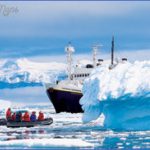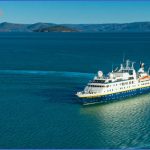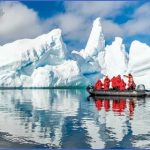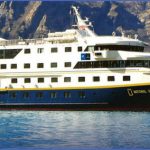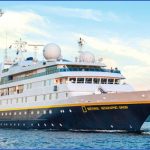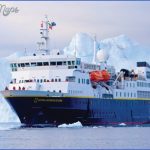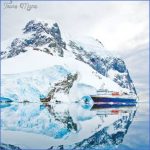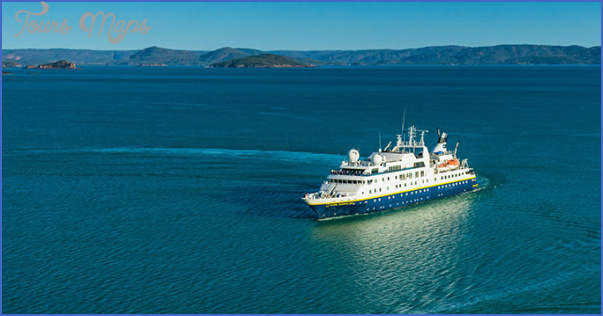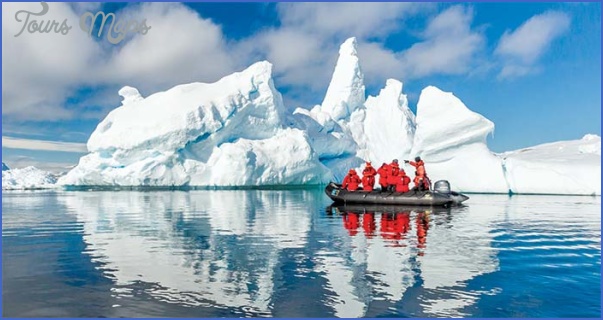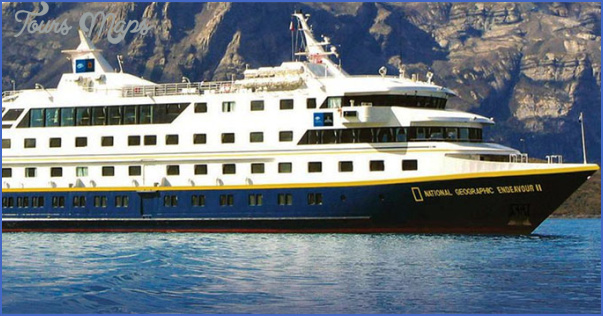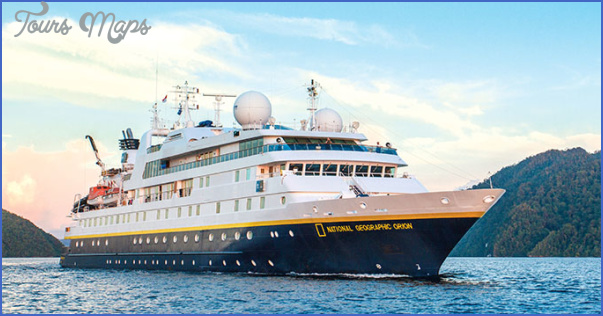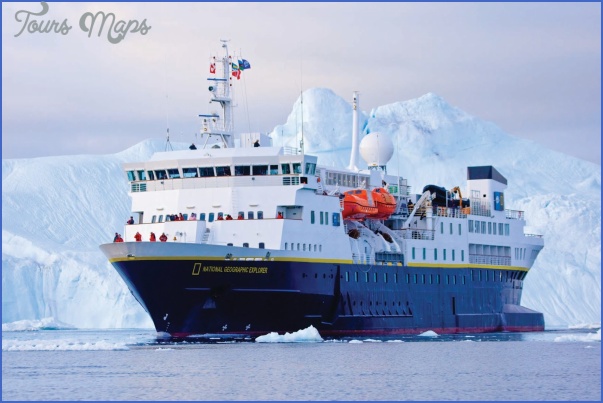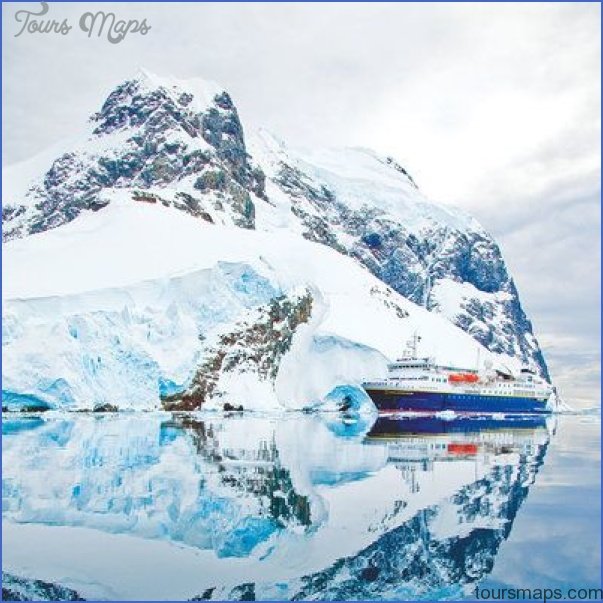Fab Programming: Lindblad has innovative, flexible itineraries and outstanding lecturers/guides. The partnership with National Geographic has resulted in many top National Geographic -affiliated photographers, explorers, scientists, and researchers joining the line’s voyages. Six naturalists are on board, for a 10-to-1 passenger-to-naturalist ratio.
Built-In Shore Excursions: Rather than relying on outside concessionaires for their shore excursions (which is the case with most other lines, big and small), Lindblad Expeditions runs its own. Excursions are superb and included in the cost of the cruise fare.
Warm Crew: The staff is friendly and accommodating.
Cost: Cruise fares tend to be higher than similar adventure-focused sailings on competing lines. Overview
In 1979, Sven-Olof Lindblad, son of adventure-travel pioneer Lars-Eric Lindblad, followed in his father’s footsteps by forming Lindblad Expeditions, which specializes in providing environmentally sensitive, soft-adventure/educational cruises to remote places in the world, with visits to a few large ports. In 2004, Lindblad Expeditions entered into an alliance with National Geographic. As pioneers of global exploration, the organizations work in tandem to produce innovative expedition programs and to promote conservation and sustainable tourism around the world. The venture lifts Lindblad’s
Educational offerings out of the commonplace.
EXPERIENCE
Lindblad’s expedition cruises are designed to appeal to the intellectually curious traveler. Passengers’ time is spent learning about life above and below the sea (from National Geographic experts and high-caliber expedition leaders and naturalists trained in botany, anthropology, biology, and geology) and observing the world either from the ship or on shore excursions, which are included in the cruise package. Flexibility and spontaneity are keys to the Lindblad experience, as the route may be altered anytime to follow a pod of whales or other wildlife. Depending on weather and sea conditions, there are usually two or three excursions every day.
ROUTES
These ships sail some interesting paths, including Antarctica and the Arctic, Southeast Asia and the Pacific, South America, Caribbean, Alaska, the U.S. and Canada, and the Galapagos Islands. In 2015, Lindblad Expeditions began sailing to the protected area known as Haida Gwaii, off the coast of British Columbia, as part of its routes through Alaska and the Pacific Northwest.
PASSENGERS
Lindblad Expeditions tends to attract well-traveled and well-educated, professional, 55-year-old-plus couples who have been there, done that and are looking for something completely different. The passenger mix may also include some singles and a smattering of younger couples. Many passengers are likely to have been on other Lindblad Expeditions programs, and they share a common interest in history and wildlife.
DINING
Hearty buffet breakfasts and lunches and sit-down dinners include plenty of fresh fruits and vegetables. Many of the fresh ingredients are obtained from ports along the way, and meals reflect regional tastes. (Lindblad chefs will search out sustainably caught local fish as part of an overall commitment to promoting sustainable cuisine.) Although far from haute cuisine, dinners are well prepared, served at single open seatings, which lets passengers get to know one another by moving around to different tables. Lecturers and other staff members dine with passengers.
ACTIVITIES
During the day, most activity takes place off the ship, aboard expedition landing craft Zodiac boats or kayaks and/or on land excursions. While on board, passengers entertain themselves with the usual small-ship activities: wildlife watching, gazing off into the wilderness, reading, and chatting. Shore excursions are included in the cruise fare. Lindblad also has an open-bridge policy rare in the cruise industry that gives travelers the opportunity to spend time on the bridge to observe and interact with the captain and staff.
CHILDREN’S PROGRAMS
Family cruising is big business, and Lindblad has family activities led by specially trained staff on all sailings. Activities have a nature slant, such as exploring an Alaskan rain forest or meeting with a local ranger in Glacier Bay National Park to work toward earning a Junior Ranger badge. Don’t expect such big-ship features as a video arcade or playroom for the little ones.
Lindblad’s newest ship, National Geographic Quest, makes her debut in June 2017 in the waters of Alaska and British Columbia. Larger and more extravagant than the line’s existing West Coast fleet, this new ship will hold 100 guests.
All 50 cabins will be outside-facing, with picture windows or private balconies.
Public areas will mirror the teal and blue of the sea outside, with a main lounge and a separate dining room. Wall-to-wall windows will line both rooms, ensuring that Alaska’s scenery is never far from sight.
Like other Lindblad ships, National Geographic Quest will be outfitted with a fleet of inflatable Zodiac rafts, kayaks, a remote-operated underwater vehicle, bow cameras, video microscope, hydrophones, and other nifty toys for getting the most out of the Pacific Northwest.
ENTERTAINMENT
Lectures and slide presentations are scheduled throughout the cruise, and documentaries or movies may be screened in the evening in the main lounge. The line’s exclusive fleet-wide Expedition Photography program features a Lindblad-National Geographic Certified Photo Instructor on every departure to help passengers take their photography skills to the next level. Several voyages are also specially designed photo expeditions that go deeper into landscape photography with National Geographic photographers on board. In 2011, Lindblad also began bringing a native Huna/Tlinglit interpreter on board its vessels in Glacier Bay to share local stories that date back before written history. The line’s Alaska sailings are also notable for the Alaska Undersea Program, which brings on board a specialist who makes regular dives up to 80 feet below the vessel with high-intensity lighting and a video camera to capture Alaska’s underwater wonders. The fascinating footage is viewed by passengers on a plasma screen in the lounge, ofen in real time.
SERVICE
Dining-room staff and room stewards are affable and efficient and seem to enjoy their work. As with other small ships, there’s no room service. The line suggests passengers leave a gratuity of $14 to $16 per person per day.
CRUISETOURS & ADD-ON PROGRAMS
Lindblad offers add-on tours that explore overland areas of Alaska like Denali National Park. These pre-and-post voyage extensions include long stays within the park itself, and a night each in Fairbanks and Anchorage. In addition to wildlife viewing, tour-goers have the choice of hiking, canoeing, fishing, and biking. The cost of the trip, which is available pre- or post-cruise, is $5,820 per person, based on double occupancy and including all meals.
FLEET
The line has eight expedition-style ships, and they vary a greatly one to the next: The 62-passenger National Geographic Sea Lion and National Geographic Sea Bird, for example, are basic vessels and have a minimum of public rooms and conveniences. The newly acquired National Geographic Endeavour II, on the other hand, features three suites, stem-to-stern Wi-Fi access, a spacious lounge, a library, and a gym and spa.
National Geographic Sea Bird – National Geographic Sea Lion
These 62-guest ships are among the most basic in the Lindblad fleet, but they’re perfectly suited to the grand regions in which they sail.
THE SHIPS IN GENERAL
National Geographic Sea Bird and National Geographic Sea Lion make their homes in Alaska, the Pacific Northwest, Baja California, and Costa Rica and Panama. As far as expedition ships go, they’re fairly utilitarian, though an extensive recent refit has left both ships with appealing new decor.
Cabins Accommodations on board are tiny but functional. An extensive 2015 refit left them looking far more cheery, though. Staterooms lock from the inside and cannot be locked from the outside, though this isn’t an issue at all on these ships. Brace yourself for the stateroom bathrooms: They’re Lilliputian, and the toilet is located opposite the showerhead.
Public areas & activities Each ship features a forward-facing observation lounge in the bow of the ship, home to a bar and small library. Most guests can be found gathering out on deck, even in inclement weather, as the hunt for wildlife continues. It’s here that these two ships excel, with bow viewing areas and two decks of outdoor promenade-style viewpoints. A small spa (a treatment room, really) and a few kinds of exercise equipment can be found on the Sun Deck.
Dining Each ship has a main dining room where all meals are served. Thanks to the intimate size of these ships (and the open-seating policy), you’ll have met all your fellow guests after a day or two. Meals are not haute cuisine, but taste like the kind of home cooking you’d get in the destination.
National Geographic Endeavour II
The successor to the recently retired National Geographic Endeavour is an improvement in every way.
Built in 2005 and extensively refurbished by Lindblad, National Geographic Endeavour II replaced the company’s older National Geographic Endeavour in the Galapagos Islands. Carrying a maximum of 96 guests, she is easily one of the more lavish ships in the region, and the second Lindblad ship to sail to the islands along with National Geographic Islander.
Cabins The ship’s 96 guests stay in 42 double occupancy staterooms and 11 single occupancy
Staterooms. All double-occupancy staterooms feature twin beds that can be converted into a queen, and every stateroom offers outside-facing picture window views. They’re simple but fine with Wi-Fi access, writing desk and chair, under-bed storage, a closet, and a bathroom stocked with botanically friendly shower products. The ship also features three suites with larger bathrooms and floor-to-ceiling windows.
Public areas & activities Lindblad has given National Geographic Endeavour II an extensive refit adding an attractive blue-teal color scheme to the vessel, along with new furnishings. The Lounge Deck is even more pleasant now, redone with light, airy materials; its floor-to-ceiling windows provide a great vantage point to admire the Galapagos Islands. On Bridge Deck, a big library faces the stern, while the ship’s navigation bridge open to guests when permissible is just a short stroll forward.
While you won’t find a pool but the ship does have a small but functional gym and spa (actually just one treatment room).
Dining The ship’s main Dining Room takes up the better half of Main Deck. Its menu consists of ingredients culled primarily from the Galapagos Islands and the mainland of Ecuador. Breakfast and lunch are buffet-style, while dinners are plated. In all instances, seating is open and meals are casual. Snacks including coffees, teas, soft drinks and cookies are available all day in the library.
National Geographic Explorer
Ice-strengthened and rugged, this ship explores some of the farthest (and coldest) reaches of the planet, outfitted with cool toys like hydrophones, high-definition underwater cameras, and even a remote-operated vehicle (ROV).
Introduced to the fleet in 2008, National Geographic Explorer was originally built for Norwegian cruise-ferry line Hurtigruten in 1982. Extensively refitted, she can carry 148 guests in 81 staterooms. Her hull is ice-strengthened and rated as Class 1A, allowing National Geographic Explorer to sail confidently in both the Arctic and Antarctica. Lindblad calls her, the ultimate expedition ship, and
That’s not far off the mark: She carries a fleet of nimble zodiac rafts for exploration; as well as 36 two-person AIRE inflatable kayaks, a high-definition underwater bow camera, a video microscope, a camera mounted to the ship’s mast that provides a far-reaching view of the terrain around the ship, and a remote-operated-vehicle (ROV) that can reach a depth of 1,000 feet. The ship also has hydrophones for listening to marine life and an open-bridge policy that encourages guests to engage with the ship’s officers.
Cabins All staterooms feature picture windows or private balconies. They come with either twin beds, twin beds that can convert to a queen, or fixed queen-size beds, depending on the category. Special staterooms designed for solo cruisers are also available. All have televisions with movies and National Geographic documentaries; reading lights; ample storage space, and surprisingly modern bathrooms that feature glass-enclosed showers and dual vanity sinks at the suite level. All bathrooms feature eco-friendly toiletries.
Public areas & activities During the daytime, you’ll often find guests on the Bridge Deck, visiting the Navigation Bridge (thanks to Lindblad’s open-bridge policy). Further aft, a well-stocked library contains titles on nearly every conceivable subject, and an adjacent observation lounge features wall-to-wall windows and skylights. On Veranda Deck, an aft-facing lounge serves as the go-to spot for lectures, daily briefings, and post-dinner nightcaps. Our favorite nook: the forward-facing Chart Room, which is brimming with books and charts and boasts the same superb view that the officers on the bridge have. Wrapped in cherry woods and brass accents, there’s also a nice bar here, too.
Unusually for an expedition ship, the National Geographic Explorer boasts a decent-sized fitness center with floor-to-ceiling windows, along with a small spa featuring two treatment rooms and a sauna. No pools or hot tubs.
Dining National Geographic Explorer ‘s main restaurant is uniquely positioned all the way forward on Upper Deck, providing fantastic views of the road ahead. Breakfast and lunch are casual, buffets, while dinners are chosen from a menu that rotates daily. Open seating is de rigueur. Off the main dining room is The Bistro, an intimate, open-seating dining venue that functions as an overflow area for the main restaurant (it has the same menu).
National Geographic Islander
Originally built to sail the Caribbean and, oddly enough, the Scottish Highlands Lindblad’s twinhulled National Geographic Islander has been sailing the Galapagos since 2004. At just 164 feet in length, she’s small enough to go where the biggest ships in the Galapagos can’t. The downside? Her catamaran design means there isn’t a lot of outdoor deck space.
Cabins Nautical in decor, National Geographic Islander has 24 staterooms and two suites on board. While all staterooms are similar, you might want to splurge for the Category 4 staterooms on Upper Deck that have solarium-style glassed-in terraces that function as a sort of pseudo-balcony. The two Category 5 suites are noteworthy for being the largest on board, wrapping attractively around the front of the ship with the same view the Captain would have one deck below.
Public areas & activities The ship has a small but attractive lounge that can seat everyone on board at once. A library and Internet center flank its forward half; and the ship’s navigation bridge functions as a sort of public room thanks to Lindblad’s great open-bridge policy. The negative to the ship’s lay out? Unless you’re a very social being, you might find yourself wishing for a quiet corner to enjoy some time to yourself.
A small (we mean small) treatment room is set in a converted stateroom The list of available spa treatments is short, but anyone looking for a basic massage will come away feeling relaxed. Sorry, no pool or fitness equipment.
Dining As with all ships in the Galapagos, ingredients are mainly local due to regulations that require companies to source food products from the Galapagos Islands or the Ecuadorian mainland. Which, frankly, Lindblad would do anyway. All meals are taken in the main dining room.
National Geographic Orion
One of Lindblad’s most lavish expedition ships, National Geographic Orion boasts the amenities of a luxury ship while sacrificing none of the educational adventure you’d expect from the line.
Built in 2003, this elegant 102-guest ship was acquired by Lindblad in 2014. Bright, spacious and airy, nearly every space on the ship features sweeping views of the ocean, from the window-lined main lounge to the ship’s central staircase and glass elevator, dramatically topped with a glass skylight. With fun toys for exploration like a full fleet of zodiac rafts, kayaks, an underwater camera, a remote operated vehicle (ROV), hydrophones, and snorkeling and scuba diving gear on warm-
Weather itineraries, this is the expedition ship that feels like a private yacht.
Cabins Six separate categories of oceanview cabins are available. Categories 1 through 4 feature oval-style picture windows, with French-style balconies on Categories 5 and 6. All are handsomely decorated (especially for an active expedition ship like this), with walnut trim and cabinetry coupled with navy blue carpeting and drapes, wall-mounted reading lights, and swanky marble-clad bathrooms with backlit makeup mirrors. It’s a look that would be right at home on a more traditional cruise ship.
Public areas & activities Public areas are where National Geographic Orion really shines, thanks to a design that brings the outside in (with windows everywhere). The social hub of the ship is the lounge on Upper Deck, which faces the stern and leads to the outdoor cafe. The lounge houses the ship’s main bar, while lectures and films are shown in the theatre on Observation Deck. The forward-facing observation lounge is also here, offering up destination-specific books and 24-hour tea and coffee machines.
Unlike most expedition ships, National Geographic Orion features a whirlpool hot tub, a fitness center and spa treatment room, and even a sauna!
Dining In addition to the main dining room, guests can dine outdoors (weather permitting) at the outdoor cafe on Upper Deck at tables and chairs overlooking the stern of the ship. Other meals are served in the main dining room, with buffet breakfast and lunch, and multi-course dinners selected from a menu that changes nightly. Seating is open.
LINDBLAD EXPEDITION S NATIONAL GEOGRAPHIC CRUISES TRAVEL GUIDE Photo Gallery
Maybe You Like Them Too
- STAR CLIPPERS CRUISES TRAVEL GUIDE
- JAMAICA CRUISES
- TRAVEL TO CABO SAN LUCAS CRUISES
- NORWEGIAN CRUISE LINE CRUISES TRAVEL GUIDE
- Passports & Identification FOR CRUISE TRAVEL

